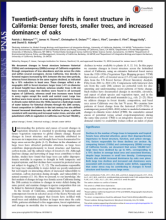Twentieth-century shifts in forest structure in California: Denser forests, smaller trees, and increased dominance of oaks

We document changes in forest structure between historical (1930s) and contemporary (2000s) surveys of California vegetation through comparisons of tree abundance and size across the state and within several ecoregions. Across California, tree density in forested regions increased by 30% between the two time periods, whereas forest biomass in the same regions declined, as indicated by a 19% reduction in basal area. These changes reflect a demographic shift in forest structure: larger trees (>61 cm diameter at breast height) have declined, whereas smaller trees (<30 cm) have increased. Large tree declines were found in all surveyed regions of California, whereas small tree increases were found in every region except the south and central coast. Large tree declines were more severe in areas experiencing greater increases in climatic water deficit since the 1930s, based on a hydrologic model of water balance for historical climates through the 20th century. Forest composition in California in the last century has also shifted toward increased dominance by oaks relative to pines, a pattern consistent with warming and increased water stress, and also with paleohistoric shifts in vegetation in California over the last 150,000 y.
McIntyre, P. J., J. H. Thorne, C. R. Dolanc, A. L. Flint, L. E. Flint, M. Kelly, and D. D. Ackerly. 2015. Twentieth-century shifts in forest structure in California: Denser forests, smaller trees, and increased dominance of oaks. Proceedings of the National Academy of Sciences:201410186.
